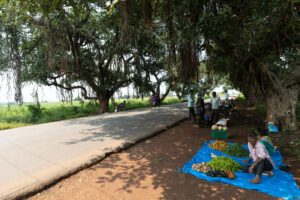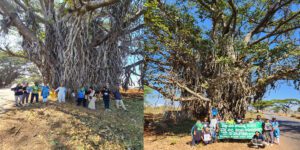Activists claimed it was the first time ever that an environment impact has been ordered for roadside trees outside forests or reserves.

‘Save Chevella Banyans’ NGT orders NHAI to conduct environmental impact assessment; says it did not take any innovative road design techniques.
The tiny seed of a mighty banyan tree is smaller than the egg of the smallest fish; when grown, it is large enough to offer shade to the entire battalion of the king viz, elephants, chariots, cavalry and infantry.
The above line was quoted by the National Green Tribunal (NGT) as it directed the National Highways Authority of India (NHAI) to conduct an environmental impact assessment study to minimise the loss of trees in a road-expansion project, and asking it to strike a balance between development and conservation.
The hearing was over the expansion of National Highway (NH) 163 — the stretch between Hyderabad and Bijapur — required the axing of over 1,000 banyan trees, some of which are a century old, to double the two-lane highway.
Most of these trees are around the Chevella locality outside the Telangana capital Hyderabad.
The bench of Justice Pushpa Satyanarayana and Satyagopal Korlapati has also given four months to the Union Ministry of Environment, Forests and Climate Change to issue of terms of reference and complete the process.
While filing the petition in December last year, the applicants — Nature Lovers Hyderabad (NLH) — said the number of banyan trees was 1,036 and the NHAI claimed the figures to be 759. However, in June this year, the NLH members told South First that they did a recount and found the number of banyan trees to be 914.
However, a committee appointed by the NGT found 915 banyan trees along the stretch (forest and non-forest areas).
The petitioners said their demand was not against the widening of the NH-163 stretch from Hyderabad to Manneguda but the NHAI to find an alternative route so that over 9,000 trees — of which they say “914” are banyans — could be saved.
Subsequently, the NGT observed that axing the trees would only cause a bigger loss as they play a huge role in carbon sequestration and containment of dust pollution and heat.
Stressing on the environmental impact assessment, the NGT said it could identify potential alternatives to reduce tree cutting, particularly, the banyans, considered an “ecosystem in itself”.

‘Save Chevella Banyans’ NGT orders NHAI to conduct environmental impact assessment; says it did not take any innovative road design techniques.
Earlier this year, in its report to the NGT, the NHAI stressed the transplantation of trees and cited previous examples of translocating banyan trees on the Hyderabad-Srisailam highway
However, the NGT opined that it might not be possible to transplant the banyan trees — which are more than 780 — as the cost incurred would be high.
It added that the transplantation was possible only for those trees whose width is not more than 65 cm in circumference, adding that any banyan tree would be more than that.
“Even if the trees are uprooted and transplanted, if they do not survive, the cost incurred would be a waste,” the NGT noted.
Expressing happiness over the NGT directive, one of the petitioners, Natasha Ramarathanam of the NLH told South First, “This is a pathbreaking and landmark judgement. We have no precedent of an environmental impact assessment for roadside trees outside forests or reserves. This case is a wedge into the mad expansion of infrastructure.”
The NGT also mentioned that the NHAI had not taken up any innovative road design techniques which would ensure an eco-friendly road layout.

Citizens lined up in front of the ‘iconic’ Banyan trees with huge trunks in Hyderabad, the winner of the 2022 World Green City Award. (Supplied)
It observed that the aim of the NHAI was only to widen the road and, during the process, it had not thought of the upgradation of the existing roads instead of expanding them.
“This is only to state that if the efficiency of the existing roads is improved the need for laying additional roads can be reduced,” the order copy read.
Suggesting alternatives, the tribunal noted that even in densely forest areas or areas with sensitive ecological features, elevated roads or tunnels could be considered as alternatives that would not require the cutting of trees.
“These structures can be designed to minimise the environmental disturbances. The report has not even considered such kind of elevated roads or tunnels for avoiding the tree-felling,” the NGT bench said.
The proposed expansion is of a 46-km stretch of NH-163 from Telangana Police Academy in the suburbs of Hyderabad to Manneguda in Vikarabad district.
The project, which is a part of the Union government’s infrastructure development plan, would affect an estimated 9,000 trees, including several hundred banyan trees, along the route.
The existing seven-metre-wide two-lane road will be widened to a four-lane road at an estimated cost of ₹956 crore.
The existing narrow stretch of the road has frequently witnessed traffic jams and accidents over the years. Due to this, locals have been demanding a better, wider road, which is also expected to reduce the travel time between Hyderabad and Vikarabad.
The NHAI had ruled out the possibility of constructing a parallel road without bothering the trees, claiming that the “entire road has a serpentine shape and most of its neighbouring area is either in the catchment or forest area”.
The NLH, in August last year, had said it geotagged as many as 914 banyan trees on the highway.

May 20, 2024

May 20, 2024

May 20, 2024

May 20, 2024

May 19, 2024

May 19, 2024